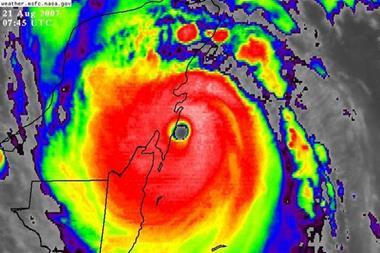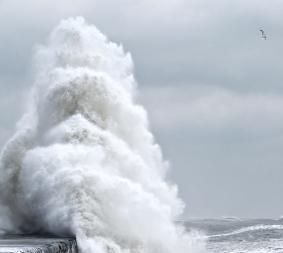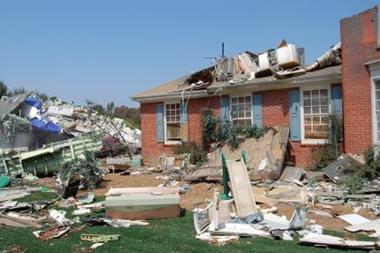The potential of climate change to alter the frequency or severity of meteorological risks is not exclusive to tropical cyclones. Other storms may also become more intense, and making property resilient is the only way to reduce losses. By Mark Bove
During the summer of 2005, in the middle of the most devastating Atlantic hurricane season on record, several scientific papers were published that indicated that anthropogenic climate change might already be affecting tropical cyclones worldwide. The scientists argued that increasingly warm ocean waters could have caused storms to become more intense over the past 30 years.1-3
Although the meteorological community is still vigorously researching and debating these conclusions, they indicate that current and future tropical cyclone risk may not be equivalent to that of the past, a conclusion that, if accurate, has tremendous implications for the management of catastrophe risk in vulnerable coastal regions.
The potential of climate change to alter the frequency or severity of meteorological risks is not exclusive to the peril of tropical cyclone, however. The wide reaching impacts of climate change is also likely to influence the behaviour of thunderstorms and winter storms. However, as in the ongoing debate about climate change and tropical cyclones, lack of historical data and the limits of computer modelling capabilities yield an incomplete understanding about how these perils behaved in the past and how they may behave in the future. Some recent studies do hint that climate change will cause - or is already causing - these perils to become more intense in some regions.
Thunderstorms
Through empirical research and ensemble global climate modelling, climate scientists have developed a good understanding of the large scale effects of anthropogenic climate change, some impacts of which are already visible today: increased land and oceanic temperatures, an acceleration in the melting of the polar ice caps and the retreat of glaciers worldwide.
4 However, it is much more difficult to determine the effects of climate change on regional or local atmospheric phenomena that exist only for a few minutes, hours or days rather than for those that last for months, years or decades.
Such is the case with thunderstorms, which are short-lived phenomena that even the most sophisticated climate models have difficulty resolving and replicating accurately. Using historical severe thunderstorm datasets to perform climate change studies is also difficult, as previous lack of consistent observation methods reduces the reliability of the data and makes it difficult to compare the past with potential changes in the future.
5,6 One way around these limitations is not to study severe thunderstorms themselves, but to investigate changes to the larger-scale environments that can spawn them. Such a study was recently conducted by a researcher at Purdue University, who examined the changes (late 20th century vs. modeled late 21st century) of three parameters critical to severe storm formation development.
7 The first parameter is called convective available potential energy (CAPE), and is a measure of the amount of energy a parcel of air would have if lifted vertically through the atmosphere. The second parameter is the amount of wind shear, differences in both wind direction and magnitude, between the earth’s surface and 6km aloft, and the third is surface humidity.
7 Increases in any or all of these factors in a future climate would make environments conducive to severe thunderstorms more common. The study indicated that there would be an increase in average values of CAPE and surface humidity in the spring and summer seasons across the eastern United States in the late 21st century, particularly along the Atlantic and Gulf of Mexico coasts. Meanwhile, average wind shear was found to decrease slightly across the continental United States. Though lower wind shear is less conducive to severe thunderstorms, the larger increases in humidity and CAPE more than compensate for this decrease in shear, resulting in an increased frequency of days conducive to severe thunderstorms over most of the eastern half of the United States, with many locations forecast to see two to three more days a year with severe thunderstorm potential.
7 While the findings from this study are forecasts for conditions 60 years from now, a few other papers hint that there is an increase in severe thunderstorms already occurring in some regions today. In the United States, one study indicates that an estimated 7% of the increase in reports of large hail (greater than or equal to 7cm in diameter) over the past 35 years is due to more frequent favourable thunderstorm environments across the United States.
6 Another region of interest is northern Switzerland and southwestern Germany. A Swiss study on agricultural hail losses found that the annual number of days where at least 100 municipalities reported hail losses has increased remarkably between 1980 and the end of the 20th century.
8 In adjacent southwestern Germany, a very strong rise in the number of days per year with high CAPE values has also occurred since the 1980s.
9 Both studies indicate that these locations may already be becoming more conducive to severe thunderstorms due to a changing climate.
Winter storms
Winter storm is a generic term for any non-tropical mid-latitude cyclone, and is somewhat of a misnomer as these types of weather systems occur year-round. However, they are at their strongest during winter months, when temperature gradients between the mid-latitudes and polar regions are at their maximum. Winter storms can produce numerous hazards that can cause extensive insured property damage, most notably high winds and excessive precipitation in either frozen or liquid form, as the winter of 2008 has demonstrated.
Both observational and climate modeling studies indicate that polar regions are warming - and will continue to warm - faster than the mid-latitudes due to anthropogenic climate change. The result is a weaker meridional temperature gradient between the regions in the lower troposphere. Since large temperature gradients fuel winter storms, the trend of weakening gradients would indicate that either the number or intensity of winter storms may decrease.
On the other hand, some studies project an increased upper-tropospheric meridional gradient and more atmospheric moisture in a warmer world – both of which foster the development of intense winter storms.10 Some climate research indicates that changes in temperature gradient patterns may also alter the locations where winter storms develop and track.11,12
Regarding the number of winter storms, several climate modelling studies tend to agree that the overall number of winter storms will decrease in a warmer climate.11-13 Regarding intensity, however, modelling studies indicate that the frequency of very intense winter storms will increase in a warmer climate, while the frequency of weak to moderate winter storms will decrease.11-13 With respect to precipitation, an increase in atmospheric moisture in a warmer climate could also result in increased probability of extreme rainfall events and flooding, though the amount of precipitation at any one location is also dependent on the forward speed of the winter storm itself.13 The increased frequency in intense winter storms will potentially have large impacts on property insurance, particularly in regions where the primary peril from winter storms is wind, such as western Europe. Historical observations already indicate an increase in intense winter storms over the North Atlantic since 1970.14 Regarding future scenarios, recent studies of winter storm loss potential in Europe using various ensembles of global climate models showed that loss ratios from intense windstorms, assuming no change in vulnerability, are likely to increase within a range from 20% to more than 100% in Germany and from 35% to more than 40% in the United Kingdom by the late 21st century.15-17 It is possible that similar increases in losses due to wind from intense winter storms could also occur in other midlatitude regions around the world.
Future loss trends
It should be noted that the results in all the research mentioned above are not definitive in their findings. Studies such as these are just the beginning of our understanding of the role of climate change on thunderstorms and winter storms, and many more years of research will be needed before any firm conclusions can be reached. Indeed, given the very local extreme effects from these storms, potential changes in the frequency and severity of thunderstorms and winter storms will probably vary widely, depending on the precise geographical region in question.
Risk is a function of hazard, vulnerability and exposed values. Even with the potential for climate change to increase the frequency and severity of thunderstorm and winter storm hazards, changes in vulnerability and exposed values will continue to dominate the risk equation for the coming decades, particularly in the United States. Since the early 1980s, insured losses due to thunderstorms in the United States have tripled from $1.7 billion per year to $5.3 billion per year (five-year averages, all values in 2007 dollars) and winter storm losses have doubled from $800 million to $1.7 billion.18
These increases predominantly result from a number of socioeconomic factors: a dramatic increase of population in regions vulnerable to these perils, urban and suburban sprawl that gives storms more targets to hit, and an increase in the values and quantity of developed real property and personal property. Since these socioeconomic trends are likely to continue for the foreseeable future, insured losses can be expected to increase as well. By the mid-to-late 21st century, however, climate change will become a larger component of observed loss trends from these perils. The only factor of the risk equation that can effectively stem or slow the rise in losses from thunderstorm and winter storms is vulnerability.
While the effectiveness of proper construction, building codes, and code enforcement in preventing hurricane damage has been dramatically illustrated over the past few years and has gained widespread acceptance, its use in preventing losses from other perils has been slow. Yet, the same techniques could also be adapted in other regions vulnerable to windstorms with the same success.
Though some tropical cyclone mitigation measures, such as hurricane shutters, are impractical for thunderstorm events, construction techniques such as hurricane straps and proper roof-to-wall and wall-to-foundation connections can reduce damage in all but the most violent of tornadoes. Similar construction techniques, as well as storm shutters, are also effective against intense winter storms. Proper roofing and siding materials can mitigate the damaged caused by hail, one of the primary drivers of thunderstorm loss. Proper roofing and insulation can also prevent common forms of frozen precipitation damage, such as ice damming.
Even if all human greenhouse gas emissions had been kept constant at year 2000 levels, a further warming of about 0.1°C per decade would be expected.19 With more energy stored in the earth’s atmosphere and oceans, it appears possible that the frequency and severity of several types of storms will increase, and property owners and the insurance industry must be prepared to face this evolving risk.
There is no way to stop the changes in climate that have already been set in motion, and it will take decades for society to respond to its implications. The best solution for mitigating property losses from the potential of increased storm risk in the near future is the same as it is today – proper building construction and code enforcement. It is a proven technique that will only prove more vital in the uncertain climate of the future.
Postscript
Acknowledgements
The author would like to thank Dr Eberhard Faust of Munich Reinsurance Company and Dr Harold Brooks of the National Oceanic and Atmospheric Administration’s National Severe Storms Laboratory for their contribution to the development of this article.
Mark Bove is a senior research meteorologist with Munich Reinsurance America. mbove@munichreamerica.com, www.munichreamerica.com
References
1. Barnett, T. P., et. al., 2005: Penetration of human-induced warming into the world’s oceans. Science. 309, 284-287.
2. K. Emanuel, 2005: Increasing destructiveness of tropical cyclones over the past 30 years. Nature, 436, 686-688.
3. Webster, P. J., G. J. Holland, J. A. Curry, and H. R. Chang, 2005: Changes in tropical cyclone number, duration, and intensity in a warming environment. Science, 309, 1844–1846.
4. Intergovernmental Panel on Climate Change (IPCC), cited 2008: 4th Assessment Report, Working Group I, 2007. Available online at www.ipcc.ch/ipccreports/ar4-syr.htm
5. Brooks, H. E., and C. A. Doswell III, 2001: Some aspects of the international climatology of tornadoes by damage classification. Atmospheric Research, 56, 191–201.
6. Brooks, H. E., and N. Dotzek, 2008: The spatial distribution of severe convective storms and an analysis of their secular changes. Climate Extremes and Society, H. F. Diaz and R. J. Murnane, eds., Cambridge University Press, 35-52.
7. Trapp, R.J, Diffenbaugh, N. S., Brooks, H. E., Baldwin, M. E., Robinson, E. D., and J.S. Pal, 2007: Changes in severe thunderstorm environment frequency caused by anthropogenically enhanced global radiative forcing. Proceedings of the National Academy of Sciences. 104, 19719-19723.
8. Schiesser, H. H., 2003: Ch. 2.6 Hagel, in: Organe consultatif sur les changements climatiques, ed., 2003 : Extremereignisse und Klimaaenderung, 65-68.
9. Potsdam Institute for Climate Impact Research, 2005: PIK Report 99: KLARA- KLIMAWANDEL - AUSWIRKUNGEN, RISIKEN, ANPASSUNG, 222 pp.
10. Knippertz, P., Ulbrich, U., and P. Speth, 2000: Changing cyclones and surface wind speeds over the North Atlantic and Europe in a transient GHG experiment. Clim. Res., 15, 109-122.
11. Leckebusch, G. C., and U. Ulbrich, 2004: On the relationship between cyclones and extreme windstorm events over Europe under climate change. Global and Planetary Change, 44, 181 – 193.
12. Geng, Quanzhen, and M. Sugi, 2003: Possible change of extratropical cyclone activity due to enhanced greenhouse gases and sulfate aerosols – study with a highresolution AGCM. J. Climate, 16, 2262-2274.
13. Finnis, J., Holland, M. M., Serreze, M. C., and J. J. Cassano, 2007: Response of Northern hemisphere extratropical cyclone activity and associated precipitation to climate change, as represented by the community climate system model. J. Geophysical Research, 112, G04S42, doi:10.1029/2006JG000286.
14. Schmith, T., Kass, E., and T.S. Li, 1998: Northeast Atlantic winter storminess 1875-1995 re-analysed. Clim. Dyn., 14, 529-536.
15. Leckebusch, G. C., Ulbrich, U., Fröhlich, L, and J. G. Pinto, 2007: Property loss potentials for European midlatitude storms in a changing climate. Geophysical Research Letters, 34, L05703, doi:10.1029/2006GL027663
16.Pinto, J.G., Froehlich, E.L., Leckebusch, G.C., Ulbrich, U., 2007: Changing European storm loss potentials under modified climate conditions according to ensemble simulations of the ECHAM5/MPI-OM1 GCM. Nat. Hazards Earth Syst. Sci., 7, 165-175.
17. Schwierz, C., Heck, P., Zenklusen, E., Bresch, D., Schar, C., Vidale, P.L., Wild, M., 2007: Modelling European winter wind storm losses in current and future climate, submitted to Climatic Change.
18. Munich Reinsurance America 2007: topics: Annual Review of North American Natural Catastrophes 2006. 44 pp. Available online at www.munichreamerica.com
19. Intergovernmental Panel on Climate Change (IPCC), cited 2008: 4th Assessment Report, Synthesis Report, 2007. Available online at www.ipcc.ch/ipccreports



















No comments yet